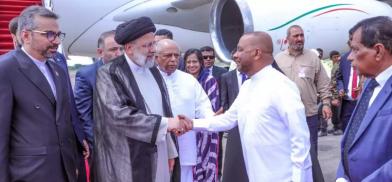Iranian president’s Sri Lanka visit is a pointer to Tehran's Indian Ocean ambitions
Before visiting Sri Lanka, Raisi visited Pakistan as part of his South Asian tour, and it is a salient factor that both Pakistan and China are equally important to the BRI as the Chinese have invested millions of dollars in both countries.

Iranian president Ebrahim Raisi’s visit to Sri Lanka last week was not a mere state visit by another head of state as the event coincided with the ongoing geopolitical upheaval in which Tehran stands at the epicentre. Thus, Raisi’s visit to inaugurate the Iranian-funded Uma Oya project sent political messages beyond diplomacy.
Historically, Iran and Sri Lanka have maintained cultural ties that date back to antiquity. Reports narrating the trade network of the Indian Ocean written by Greek navigator Cosmos mentioned that Persian merchants often visited the ports in Sri Lanka during the kingdom of Anuradhapura. A trilingual inscription carved by Chinese Admiral Zheng He in the 15th century contained Persian as one of the languages, which indicated the early Persian influence on the island. Since the inception of the Islamic Republic of Iran as a theocratic state, Colombo continued to have ties with Teheran in many layers.
During President Ranasinghe Premadasa’s era in the late 80s, Iranian influence began to increase in certain aspects of his foreign policy, which became evident when Israeli diplomats were expelled from Colombo. It was believed that his then foreign minister ACS Hameed influenced the decision as he is said to have had close links with Iranians.
Against this backdrop, the visit of Dr Ebrahim Raisi conveys an important message. From a strategic perspective, Iran has been striving to expand its naval capabilities towards the southern hemisphere since 2010 and Sri Lanka’s importance as a strategic hub in the Indian Ocean has become a natural choice for Tehran. It was in 2013 that Iran sent its first flotilla consisting of two warships and one submarine to Colombo harbour as a port visit, and this occurred even before the Chinese sent its submarine to Colombo in 2014. Since 2013 Iran has engaged closely in the maritime domain with Sri Lanka with several port visits signifying Iran’s strategic tilt towards the Indian Ocean Region.
Signal to the West?
Amidst the escalation with Israel, the visit made by the Iranian leader is intended as a signalling to the West that the states in the Global South such as Sri Lanka and Pakistan stand along with Tehran against the West. Raisi’s visit was followed by a speech delivered at the largest mosque in Colombo where he addressed local Muslim leaders, students and imams. The political symbolism emanating from this gathering was akin to any anti-Western rhetoric from Iran. In the context of Sri Lanka, however, the public opinion towards the Middle East issue is a twisted one. The Islamophobic feelings erupted in the aftermath of the Easter attacks and ultra-nationalist Sinhalese groups’ admiration for Israel continued to counter anti-Zionist protests on the island. Given this anomalous situation that prevailed, the Iranian supreme leader's address before the Muslim leaders in Colombo projected a picture of Sri Lanka as a state that stands against Israel, but which is not the true picture.
It should be borne in mind that Sunni Muslims are the dominant sect of the Sri Lankan Muslim society and traditionally the Muslims in Sri Lanka have looked for Sunni states such as Saudi Arabia and Pakistan for mentoring. However, the pro-Iranian syndrome developing in Sri Lanka creates a perplexing situation, which would eventually challenge the Saudi influence in Muslim society. For instance, the Iranian-backed Dowdi Bohra centre in Colombo has gained rapid popularity among local Muslims.
All these factors appear to be pivotal in signifying the message conveyed by the Iranian leader to the Muslim community as it marks Teheran’s growing footprints in Colombo. On the face of it, Iran fulfilled one important strategic goal by seeking to influence the Muslim community on the island, which might elevate the status of Iran in future to the level of an influencer. It remains to be seen how Saudi Arabia seeks to counter this.
Besides his social outreach, Raisi pushed for greater economic cooperation between the two countries. The Sri Lanka-Iran ‘tea-for-oil’ barter agreement is now making strong progress and Sri Lanka has already settled payments to the tune of over USD 20 million to Iran. The slogan “tea for oil” resembles how Sri Lanka in the 50s sought rice from China by exporting rubber and the same mechanism seems to have been adopted in this compelling deal with Iran.
The China factor
The growing political and economic relations between Iran and Sri Lanka will be a concern to the US. Iran is well aware of the status of Sri Lanka’s economy, which is in the doldrums. Both Sri Lanka and Iran are also partners in Beijing’s Belt and Road Initiative. The global order that has emerged after the Russian invasion of Ukraine in 2022 is tantamount to a new axis consisting of Moscow, Beijing and Teheran. Before visiting Sri Lanka, Raisi visited Pakistan as part of his South Asian tour, and it is a salient factor that both Pakistan and China are equally important to the BRI as the Chinese have invested millions of dollars in both countries.
All in all, Raisi’s visit to Sri Lanka appears to be a part of an Iranian geostrategic outreach campaign to the Indian Ocean amid the tense situation in the Middle East. It is indeed a strategic gesture to extend Tehran's sphere of influence in two countries engulfed by economic crisis. Moreover, West's frequent criticism of Sri Lanka over many issues has encouraged Teheran to depict itself as a friend in need. The question that policymakers in Colombo should be concerned about is how to deal with the political and diplomatic repercussions of its hobnobbing with Iran.
(The author is a post-doctoral researcher affiliated with the Institute of Law, Politics and Development at Scuola Superiore Sant Anna, Pisa, Italy. Views are personal. He can be contacted at punsaraprint10@gmail.com )









Post a Comment